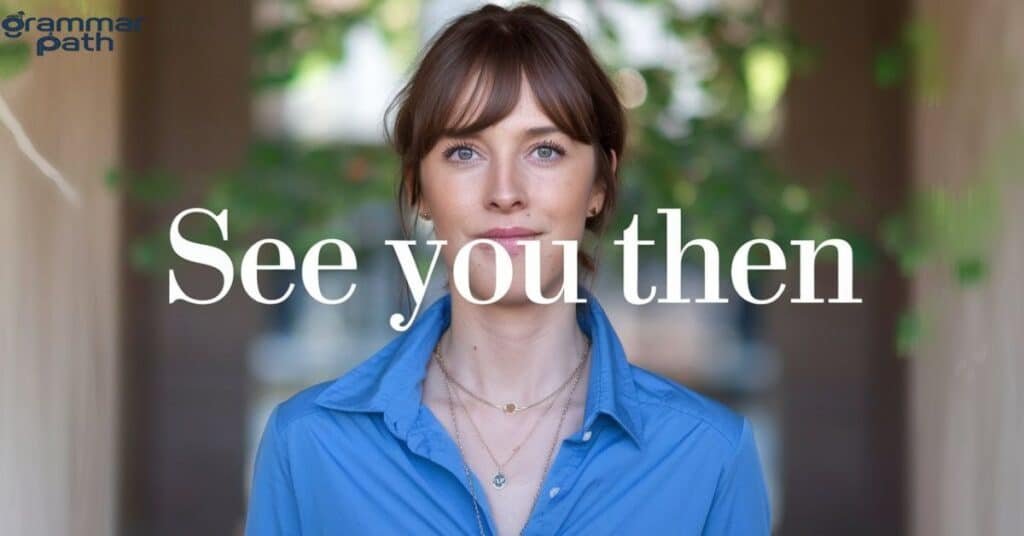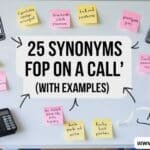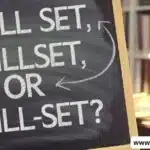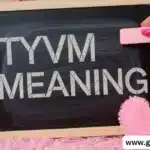“See you then” is a phrase you’ve likely heard countless times, whether in professional settings, casual conversations, or everyday texts. At its core, it’s a simple yet effective way of confirming a future meeting or event.
Whether you’re exchanging emails with a colleague or texting a friend, this phrase ensures clarity in communication and conveys a sense of certainty. It’s not just about saying goodbye—it’s about creating a bond that sets an expectation for when you’ll reconnect.
For example, in an email to confirm a meeting, you might say, “Let’s meet at 10 AM. See you then!” It’s efficient, to the point, and leaves no room for misunderstanding.
What makes “see you then” so intriguing is its versatility. It can effortlessly transition between formal and informal settings without losing its meaning.
In professional conversations, it can be used to confirm appointments and meetings, creating a polite and respectful tone. On the flip side, when you’re texting friends or family, it comes off as relaxed and friendly. Understanding how to properly use this phrase is essential for mastering both professional and casual communication.
Key Takeaways
- “See you then” is an essential phrase that confirms future meetings or plans.
- It can be used in formal responses and informal settings without losing its meaning.
- There are plenty of alternative phrases that can add variety to your conversations.
- Learning how to respond to “see you then” appropriately ensures clarity in communication.
Other Ways to Say “See You Then”
Here are the ways to say “see you then”:
- Looking forward to it
- Until we meet again
- Catch you later
- Can’t wait!
- See you soon
- Ok, see you then
- Sounds good, see you there
- Looking forward to our meeting
Here are a few alternative ways to say “see you then” depending on the context:
- “Looking forward to it” – Perfect for formal exchanges where enthusiasm needs to be balanced with professionalism.
- “Until we meet again” – A refined, formal option often used in professional or sentimental contexts.
- “Catch you later” – A casual, laid-back way of saying goodbye when plans are already set.
- “Can’t wait!” – Ideal for informal exchanges when you’re excited about the upcoming meeting.
A Refined Rendition: “Until We Meet Again”
For those looking for a more polished or formal alternative, “Until we meet again” offers a refined and elegant way to express the same sentiment as “see you then.” This phrase carries a sense of anticipation but with a softer, more thoughtful tone. It’s often used in professional emails or in situations where the conversation holds emotional significance.
Imagine you’ve just concluded a successful presentation, and you want to leave a lasting impression. Instead of saying the usual, “see you then,” you could say, “Thank you for your time today. Until we meet again.” This adds a layer of sophistication and makes the conversation feel more memorable.
However, be mindful of when to use this phrase. “Until we meet again” might feel too formal for casual interactions with friends or family. In such cases, it’s better to stick with simpler options like “see you soon” or “catch you later.”
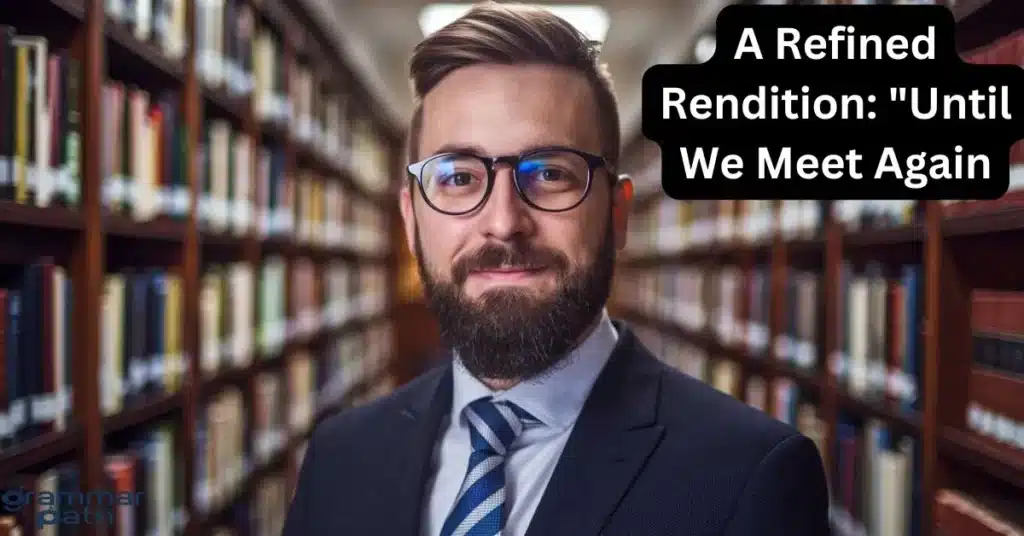
How to Answer Formal
Responding to “see you then” in a formal setting requires a degree of professionalism, but that doesn’t mean it has to sound robotic. A well-crafted response can convey politeness and enthusiasm. When replying to a formal email where someone says “See you then,” try responding with something like, “Thank you, I’ll see you at the agreed time.” This confirms the meeting and maintains the professional tone.
For example, if your manager emails you about a project update meeting, their message might end with “See you then.” In this situation, a polite response like, “Thank you for confirming. I’ll see you at 2 PM,” strikes the right balance between professionalism and courtesy.
Pro Tip: In formal settings, it’s best to avoid overly casual responses. Keep it professional by sticking to phrases like “Looking forward to our meeting” or “I’ll see you at the scheduled time.” This ensures clarity and shows respect for the engagement.
“Catch You Later”
“Catch you later” is an informal variation of “see you then,” often used in casual or friendly conversations. It’s a fun, laid-back way of saying goodbye while still implying that you’ll reconnect at some point in the future. This phrase is commonly used in texts or verbal conversations when formality isn’t necessary.
For example, imagine texting your friend about weekend plans. You’ve agreed to meet for coffee, and they text you, “Let’s meet at 11 AM at the café.” Instead of replying with “see you then,” you could say, “Great, catch you later!” This adds a more personal touch and keeps the conversation casual.
It’s important to note that “Catch you later” should generally be avoided in formal situations. It may come across as too casual for professional exchanges or emails with clients and supervisors.
How to Answer Informally
In informal situations, replying to “see you then” gives you a lot more flexibility. You can keep your responses light and conversational, without worrying about maintaining a professional tone. A quick, friendly response such as “Sure, see you!” or “Ok, see you then!” works perfectly well in these settings.
Let’s say your friend Alex texts you about meeting up for dinner. They write, “Let’s meet at 7 PM. See you then!” Your informal response could be something like, “Sounds good! See you there!” This response is casual, friendly, and keeps the conversation flowing naturally.
You can also get creative with your replies based on your relationship with the person. Responses like “Can’t wait!” or “Looking forward to it!” can show enthusiasm and excitement for the upcoming event.

Is It Correct to Say “See You Then”?
Yes, “see you then” is not only correct but also widely accepted in both formal and informal conversations. Its flexibility makes it suitable for emails, texts, and even face-to-face interactions. The phrase effectively confirms a meeting or event, ensuring that both parties are aligned.
For example, you might be confirming a meeting with a colleague. An email exchange could go like this:
- You: “Let’s meet at 3 PM tomorrow.”
- Colleague: “Perfect, see you then!”
This exchange highlights how naturally “see you then” fits into professional correspondence. Similarly, in more relaxed settings, using this phrase shows that you’re on the same page and committed to meeting up.
However, the key to using “see you then” effectively is context. In formal situations, it may be better to pair it with polite language. In informal conversations, you can keep it short and casual without losing any clarity.
Pro Tip: The most important takeaway is learning how to adjust your language based on context. Whether you’re in a formal meeting, writing an email, or texting a friend, understanding the tone and setting will help you use the right phrase effectively.
Conclusion
To wrap up, “see you then” is a versatile phrase that you can incorporate into almost any conversation, whether formal or informal. Its simplicity is what makes it so powerful—by saying these three words, you’re confirming a future interaction while setting the tone for how that interaction will play out.
For those looking to refine their communication, remember to experiment with alternative phrases such as “Looking forward to it” or “Until we meet again” when the situation calls for more nuance. At the same time, don’t be afraid to use casual phrases like “Catch you later” in informal exchanges with friends or family.

Emily Olivia is an experienced writer specializing in grammar and English language topics. With a passion for clarity and precision, she shares valuable insights on synonyms, grammar rules, and writing tips to help readers enhance their language skills on Grammar Path.

